THE INDEPENDENT STUDENT NEWSPAPER OF THE UNIVERSITY OF PENNSYLVANIA • FOUNDED 1885
PHILADELPHIA, THURSDAY, OCTOBER 5, 2023

THE INDEPENDENT STUDENT NEWSPAPER OF THE UNIVERSITY OF PENNSYLVANIA • FOUNDED 1885
PHILADELPHIA, THURSDAY, OCTOBER 5, 2023
RAs are waiting for the National Labor Relations Board to certify the 142-22 vote
JONAH MILLER Senior Reporter
In a 142-22 vote, Penn residential advisors and graduate residential advisors overwhelmingly voted to form a union after the votes were tallied Thursday night.
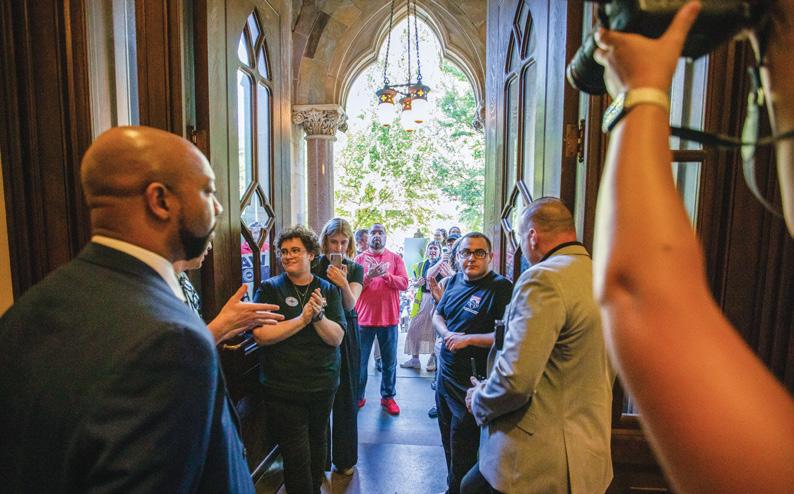

The vote represented an approximate 75% turnout from Penn’s nearly 220 RAs who are organizing under the Local 153 branch of the Office and Professional Employees International Union. Now, RAs are waiting for the National Labor Relations Board to certify the results before taking next steps.
Voting took place over two days, from Sept. 27 to 28, in the Golkin Room on the second floor of Houston Hall.
“It felt empowering to cast a ballot and contribute to the historic unionization of undergraduate and graduate student workers on Penn’s campus,” College senior Conor Emery and second-year RA in Harnwell College House said. The vote to form a union came over six months after a supermajority of RAs filed to unionize under OPEIU Local 153 and the NLRB. Penn then alleged that the RAs were not employees of the University but instead attempted to classify them as student leaders with an “educational relationship” to Penn since they are not on the payroll. In August, however, the NLRB recognized Penn RAs and GRAs as employees of the University, ordering an official union vote.
In a statement to The Daily Pennsylvanian, University spokesperson Ron Ozio wrote that “The NLRB must certify the election outcome, at which time we will provide more information to the RAs and GRAs.”
“We thank the RAs and GRAs who participated in this important process,” Ozio wrote in the statement.
RAs and GRAs present at the ballot count expressed excitement for the results, some saying that the election felt like a culmination of their work.
“Achieving unionization gave me a rush of relief, but it also felt exhilarating because bugging my coworkers for the last month paid off,” College sophomore and Fisher-Hasenfield College House RA Omar Elsakhawy wrote to the DP. “This sets a precedent, both practically and legally, for RAs at other institutions seeking better working conditions and democratic representation.”
See RAs, page 6


Hundreds of students and community members were turned away from College Hall after attending a rally yesterday
MOLLY COHEN, SOPHIA LEUNG, AND HALEY SON Senior Reporter and Staff ReportersRoughly 300 rally goers attempted to enter College Hall this afternoon after showing their support for graduate student workers’ push for union recognition.
The rally, organized by Graduate Employees
Together University of Pennsylvania-UAW, began on College Green at noon on Oct. 4. Following speeches from multiple graduate students and community members, the crowd walked toward College Hall. Some organizers successfully entered the building and delivered a letter with nearly 500 signatures directed to President Liz Magill and Provost John Jackson.
Upon approaching College Hall, around 14 rally goers — including several GET-UP organizers and representatives from the UAW — were allowed
to enter the building before security guards and Open Expression Observers stopped others from entering the building. Outside the building, the other attendees chanted, “let us in” for about 10 minutes.
The organizers who were able to enter the building said they intended to deliver the letter to Magill’s office. It was unclear whether or not Magill or Jackson were present in the building, but after a couple of minutes of chanting and knocking on their respective office doors, a representative from the Provost’s Office came into the lobby to receive the letter from UAW Region 9 Director Dan Vicente.
“They were too cowardly to come out themselves,” Vicente, a former member of the Local 644 union, said. “They sent their staff, but let’s let them know something: You can’t run from this.”
A University spokesperson confirmed that the letter was delivered to College Hall and received by a representative in the Provost’s Office.
“The President and the Provost were in previously scheduled meetings outside of College Hall at the time,” the spokesperson wrote. “Open expression observers were present at the rally.”
The letter — addressed to Magill and Jackson — said that GET-UP intends to file a petition with the National Labor Relations Board, adding that their unionization efforts follow similar patterns taken by other unions at Penn and peer universities. Organizers at the rally said that over 2,700 Penn See GRADUATE STUDENTS, page 2
Over 20 years after Penn demoted her, Karikó was recognized for her and Weissman’s mRNA research that helped develop vaccines to mitigate the spread of COVID-19
BEN BINDAY, SINA SHAIKH, AND NICOLE MURAVSKY Senior Reporter and Staff ReportersPenn Medicine researchers Katalin Karikó and Drew Weissman were named winners of the 2023 Nobel Prize in Medicine on Monday.
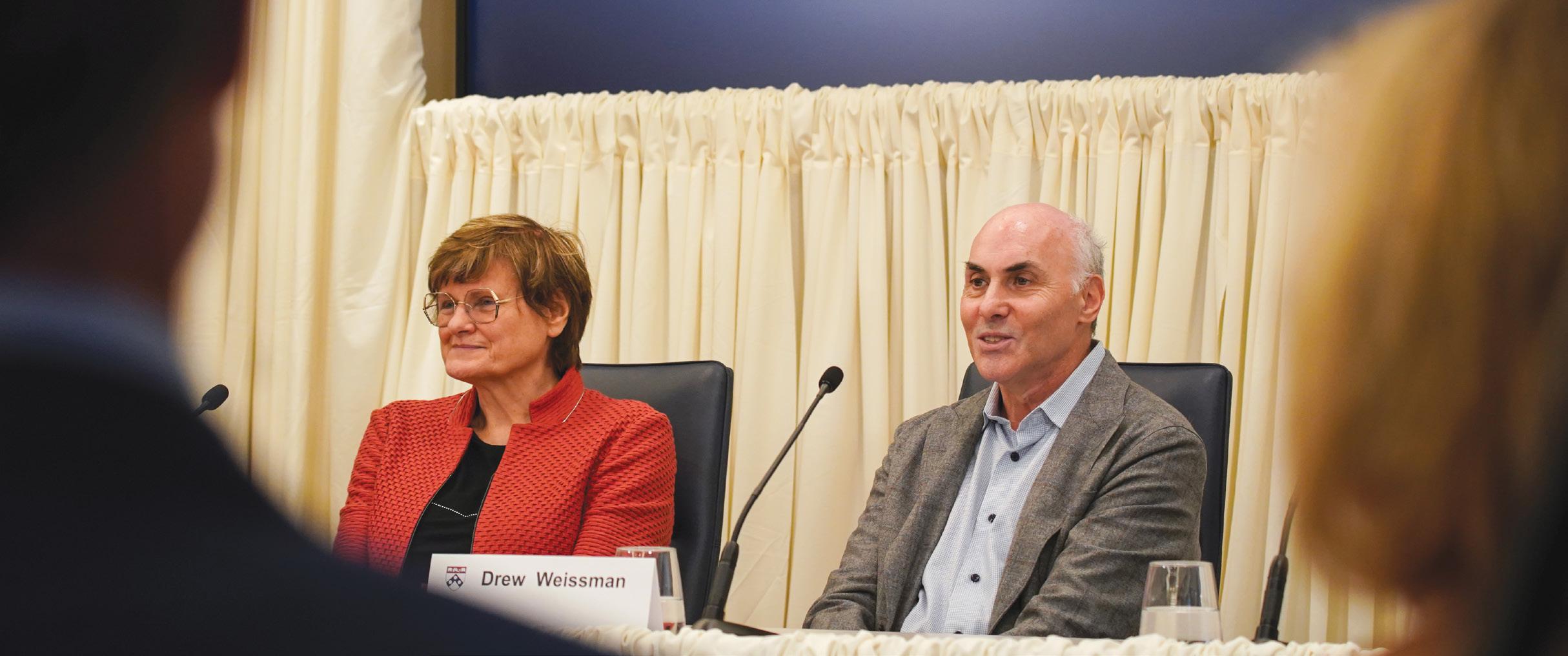
Karikó, an adjunct professor of neurosurgery at the Perelman School of Medicine, and Weissman, the Roberts Family Professor of Vaccine Research at the Perelman School of Medicine, won the award for their past research into messenger RNA technology on Oct. 2. Their research — primarily a groundbreaking 2005 study — was critical in the development of Pfizer/ BioNTech and Moderna’s COVID-19 vaccines.
Penn President Liz Magill congratulated Karikó and Weissman on their accomplishments at a press conference this morning.
“We are bursting with pride of our Nobel laureates and the extraordinary work they have done to serve so many across the globe,” Magill said. “At a University built around [a] Franklin spirit, there are no better exemplars of these character traits than our Nobel laureates, Dr. Kati Karikó and Dr. Drew Weissman.”
More than 655 million doses of mRNA COVID-19 vaccines have been administered since their release in December 2020, according to Penn Today.
Executive Vice President of the University of Pennsylvania Health System and Dean of the Medical School Larry Jameson emphasized the magnitude of Karikó and Weissman’s findings at the press conference.
“The achievements of Dr. Weissman and Karikó have changed the course of history,” Jameson said. “Since the rollout of two mRNA vaccines in 2020, millions of lives have been saved, and scores of others have been protected from severe disease, even in the face of an increasingly transmissible virus.”
In the 1990s, Karikó was on the path to professorship at Penn, but she was demoted after the University saw her work as too financially risky to fund. She stayed at Penn until 2013 but was never reinstated to her position even after the University patented the technology from Karikó and Weissman’s 2005 research.
“Ten years ago I was here in October because I was kicked out and forced to retire," Karikó told the Nobel Prize organization. In an interview with Endpoints News last week, Karikó said she was told that once she retired, she could not come back to Penn. Some academics have called on Penn to apologize for celebrating Karikó's
Nobel Prize despite their treatment of her.
“We acknowledge and are grateful for the valuable contributions Dr. Kariko has made to science and to Penn throughout her time with the University,"
doctoral, master’s, and undergraduate student workers had signed authorization cards to form a union.
“While we work in diverse academic and professional fields, we are united by a desire to improve our working conditions as well as the quality of teaching and research at Penn,” the letter reads. “Through collective bargaining, we aim to make Penn a stronger, more inclusive and equitable institution.”


GET-UP organizers said that they are also planning to send the letter to Magill via email. Organizer Jordan Williams said that the University will have until Oct. 6 to voluntarily recognize the union before graduate workers officially file for approval from the NLRB.
The several hundred rally goers remaining outside College Hall continued to chant, demanding that the Division of Public Safety allow them to enter the building. The crowd retreated after organizer and Penn graduate student Hilah Kohen said they were told by a present Open Expression Observer that they could not enter due to building capacity limits.
In a statement to The Daily Pennsylvanian, DPS confirmed that approximately 14 of the organizers were allowed to enter College Hall.
“They were asked to limit their representation to approximately 10 people for safety reasons,” the statement said. “The remainder of the group continued their rally outside on the steps of College Hall.”
DPS added that “Open Expression engaged with the organizer to understand their goals and how they could be accommodated.”
Students in class inside College Hall were permitted to exit the building after class ended at 1 p.m., but no new rally goers were allowed to enter.
Prior to approaching College Hall, rally goers heard speeches from GET-UP organizers in various departments across the University, as well as representatives from supporting unions and local councilmember Kendra Brooks.
Brooks, the first Working Families Party member to be elected to city council in Philadelphia, discussed the unionization efforts in the context of Philadelphia at large.
“By forming a union, you are standing up not just for yourselves,” Brooks said. “You are standing up for all Penn workers, all academic workers, and all working families in Philadelphia.”
Ayesha Sheth, a seventh-year graduate student in the South Asia Studies department, spoke on the specific struggles of international students in graduate programs at Penn.
“Penn continues to view us as cheap labor, a vulnerable population whose very right to stay here they can control,” Sheth said, recalling the lack of support she said her peers received from the University during the COVID-19 pandemic.
GET-UP organizer and sixth-year Ph.D. student Sam Schirvar said that he was disappointed that Penn administrators appeared to have not been willing to receive the letter in person. He said
that GET-UP had set up and practiced with crowd marshals, equipped with high-visibility vests, to ensure that rally-goers would remain safe and respectful for the duration of the rally.
“It was clear they just didn’t even want to receive the letter at all,” Schirvar said.
Chemical and biomolecular engineering graduate student Sam Layding was one of the organizers who was allowed to enter the building.
“We just wanted to come in here to hand deliver our letter to the president and the provost, to let them know that we’re going to file for union election later this week, and that we would appreciate it if Penn would respect the legal process of our filing,” Layding said. “We’ve delivered our letter, so I think that we’ve come in here to do what we came to do.”
In the letter, students and organizers referenced Penn’s history of allegedly engaging in unionbusting tactics. The Daily Pennsylvanian previously reported that six months after a supermajority of residential advisors filed to unionize under OPEIU Local 153 and the NLRB, Penn alleged that the RAs were not employees of the University but instead attempted to classify them as student leaders with an “educational relationship” to Penn since they are not on the payroll. In August, however, the NLRB recognized Penn RAs and GRAs as employees of the University, ordering an official union vote. The RAs and GRAs voted to unionize this past week.
“We’ve been disheartened to see the University
administration’s delays, spurious legal objections, and refusal to listen to majorities of museum employees, resident physicians, and residential advisors who seek to unionize,” the letter reads.
“We hope that moving forward, Penn will respect the democratic will and self-determination of University employees rather than attempt to persuade workers not to unionize.”
The letter also requests a meeting with Penn administration “to ensure a fair and efficient process to verify majority support for GETUPUAW as our union.”
Schirvar told the DP that the rally was a celebration of the fact that a supermajority of graduate workers have signed authorization cards.
“We’re asking that the Penn administration recognizes the fact that a majority of workers have signed union cards and allow us to hold a union election without trying to interfere with the decision making of graduate workers by putting forward misinformation and misleading statements as they have done with other workers at Penn in the past,” Schirvar said.
College Ph.D. student and GET-UP field coordinator and organizer Luella Allen-Waller agreed, adding that the authorization cards represent the “democratic will” of the graduate workers.
Previously, on April 26, over 200 Penn graduate student workers rallied outside of Van Pelt Library to advocate for improved working conditions, financial security, and protection against discrimination.

The new policy details numerous adjustments to how human remains are presented and used throughout the Museum and University settings
DEDEEPYA GUTHIKONDA Senior ReporterPenn Museum will no longer allow “exposed human remains” to be displayed in an update to its human remains policy.
The policy — which was published after the Museum's Human Remains Policy Committee approved a draft in May — provides “a rigorous basis for the ethical treatment of human remains in the Penn Museum,” according to the Penn Museum website. It details numerous adjustments to how human remains are presented and used throughout the Museum and University settings, following years of activist demands.
Under the new policy, human remains are defined as “anything that came from a person,” including skeletons, cremated remains, and hair and bone. Applying this definition, the Museum currently holds over 10,000 human remains from across the globe, the policy reads.
One of the Museum's collections — the Morton Collection — houses over 1,300 human crania. In 2022, Rutgers University professor Lyra Monteiro and local activist Abdul-Aliy Muhammad filed objections to Penn Museum’s petition to Philadelphia Orphans’ Court to bury the remains of Black Philadelphians in the Morton Collection. A Philadelphia court judge later declared that the activists had no standing and granted Penn Museum’s request to bury 20 Black Philadelphians in the Morton Collection.
A Penn Museum spokesperson wrote to The Daily Pennsylvanian that fully wrapped remains, or remains contained in coffins, will be considered for display contingent on some criteria.
“The museum ‘needs’ to be able to display the mummified remains of ancient Egyptians, so they built in an exception to allow the display of covered or wrapped human remains," Monteiro and Muhammad wrote. "They have written exceptions like this into each part of the policy — there’s always a way out of it."
In addition, the policy says that the Museum will limit how often human remains are used in educational settings, adding that “research requests concerning human remains are subject to rigorous review prior to approval.”
Students in lower-level classes will not handle
Penn Museum currently holds over 10,000 human remains from

globe. remains directly, while the Museum will review requests to include remains in classes. Upper-level undergraduate and graduate classes may access human remains using a class-use request.

“Prioritizing human dignity and the wishes of descendant communities are the governing principles behind this essential institution-wide update to the Penn Museum’s Human Remains Policy,” Penn Museum Director Christopher Woods wrote in a statement.
Woods added that the Museum's new policy is part of an ongoing effort to address its past actions.
"Confronting our institutional history tied to colonial collection practices requires continuous examination and assessment of our policies," Woods wrote. "It is our moral, ethical, and social responsibility."
However, Monteiro and Muhammad criticized the impetus of the policy update, writing, "It is about the Penn Museum trying to restore their reputation after multiple international scandals related to the abuse of ancestors by their museum’s staff."
The Museum spokesperson told the DP that the Penn Museum plans to increase staffing to support the international repatriation of human remains not covered by the Native American Graves Protection and Repatriation Act, which dictates federal policy for treating Native American remains.
Monteiro and Muhammad wrote that while the Human Remains Policy “considers” and “discusses” how to handle human remains, “using the stolen remains of ancestors” is something they should not be doing in the first place.
“The Committee emphasized the need to
communicate the difficult historical reasons for the Museum’s holdings,” the policy states.
Previously, the DP reported that Penn Museum removed the remains from the Morton Collection from public view, although a Penn Museum spokesperson wrote that the remains were in a private classroom. Penn community members held a protest in April 2021, days before the Museum and University issued an apology and announced plans for repatriation.
According to a Penn Museum spokesperson, the new policy says that "the Museum will provide space for next-of-kin and descendants to access, view, and honor individuals housed in the Museum."
However, Monteiro and Muhammad said that they do not believe the Museum's policy extends far enough.
“Despite emphasizing the plan to engage descendant communities, the policy does not offer any mechanism for descendants or other concerned parties to report violations of the policy — much less explain what would happen if the policy is violated,” they wrote in a statement to the DP.
In 2021, the Penn Museum faced heavy scrutiny for holding onto the remains of MOVE bombing victims, which the University investigated. While any known MOVE remains were received by the Africa family in July 2021, activists alleged that Penn Museum holds previously undisclosed remains of MOVE bombing victims this past month.
Among Monteiro and Muhammad’s objections in court was the lack of descendant input in the treatment of the Morton Collection, as Penn
Museum planned to bury the remains without identifying the deceased or attempting to connect them with their descendants.
The new human remains policy is an ongoing process subject to an annual review. It follows a “Statement on Human Remains” published in 2017 and recommendations developed by the Morton Collection Committee regarding the treatment of the Morton Collection in April 2021. The Committee recommended that “the Museum should reassess its practices of collecting, storing, displaying, and researching human remains.”
The Human Remains Policy was first drafted between October and November of 2022 by the Museum's Human Remains Policy Committee, which was composed of representatives from both the Museum and the University.
“Centering the wishes of the descendant community would mean actually engaging them in the process of drafting this policy,” Monteiro and Muhammad wrote. “At no time were we contacted about this policy that claims to center descendant community wishes.”
The policy also says that human remains "collected unethically and without permission" will not be available for research or teaching, except for repatriation or community restoration research purposes. Monteiro and Muhammad expressed concerns that repatriation is not discussed widely enough.
"The entire policy is approached from the standpoint of what the museum and its visitors need, not what the dead and their descendants need," they wrote in a statement.
unburdened by accountability, raises the question of where our peers’ genuine moralities and beliefs lie.
Considering the amount of imposter syndrome Black students in elite institutions internalize without Sidechat, seeing reminders of them online becomes inescapable. Even when some students don’t regularly use Sidechat themselves, the discourse offered on the platform influences general points of conversation on campus. It feels nearly impossible to have genuine interactions with other students when faced with the reality that they could’ve been among the hundreds of people who liked or authored a distasteful post themselves.
platforms like this, certain harmful posts can fall through the cracks and gain traction before they are removed. Additionally, when some of these posts garner a lot of attention, it signifies to others that what they say must be the truth, even if it may be rooted entirely in their opinion.
All things considered, Sidechat can be a useful platform, with its relatable content, funny memes, and general advice on how to navigate life at Penn. Even I tend to frequent it when the stress of classes becomes overwhelming.
Many students at Penn and throughout the nation remember the Supreme Court’s ruling striking down affirmative action in the college admissions process this summer. While many individuals publicly expressed the nuances behind the decision and what this could mean for the future of higher education, others took a more anonymous approach.
Away from the spotlight of public scrutiny, some individuals on Sidechat took the opportunity to “note general trends” of incompetency among Black and Hispanic students. Even when other users attempted to point out the blatant form of prejudice in the post, a number of responses rebutted

that “if you don’t like it here then don’t move here”. That’s all to say that some of us were already here long before considering college, and that every student has the right to express issues central to their identities while pursuing an education.
Most students don’t consider that even if their identity doesn’t leave the safety of the online platform, much of the comments they make do: whether it’s questioning if students of color deserve their place on campus after affirmative action, or if financial aid should prioritize middle-class students by disregarding low-income ones. The knowledge that individuals throughout campus are making these comments on Sidechat, when
This is especially relevant when applied to the broader context of Philadelphia, a city with a long history of racial injustice and dehumanization of Black people in neighboring communities. The beliefs that spread on campus are not just confined to the Penn bubble. They become actions that students use to navigate the city and policies that impact the future of communities like mine. Pushing narratives that people fall within specific boxes, mainly serves to drive a wedge between them.
Despite all of the achievements many students at Penn earn, a lack of cultural awareness is not something that can be remedied through the back and forth arguments rampant on Sidechat. Many students believe that their place at this school validates the way they look down on others, even when they lack the lived experiences of the people they are looking down upon. Even when moderators are meant to limit the amount of misinformation that circulates through
However, the judgements made about deeper social issues tied to the city and its inhabitants need to be made with greater nuance. Moving forward, it’s important to consider the intent behind some of the posts made, especially when they only supply one person’s perspective of any given event. While Sidechat can be a helpful way to become familiar with issues currently circulating campus, it’s necessary for users on both sides of the platform to consider how far they want their message to go.
Writing in anonymity does not absolve anyone from their responsibility to reassess their biases and think twice before they make comments that can further harm disadvantaged people. Nothing online exists within a vacuum, especially when it informs how other students go out into the world and shape the spaces around them.
HANADI ABDULKADIR is a College sophomore studying international relations from Philadelphia. Her email is hanadia@sas.upenn.edu
THE AIYER ASSESSMENT | Underfunded and understaffed, the Philadelphia School District needs Penn to pay PILOTs
Across 217 public schools and 124,111 students, there are only four certified school librarians in the entire city of Philadelphia. While that may not come as a surprise given how underfunded the Philadelphia School District is, it should come as a concern.
School librarians have been proven time and time again to make a positive difference in students’ academic achievement. Within the state, almost 8% more students received a score of Advanced on the Pennsylvania System of School Assessment in reading when they attended schools with fulltime librarians, in comparison to those without. For vulnerable learners, such as students of color and low-income students, good school librarians boost academic achievement by an even larger margin. That’s an important distinction, given that 85.5% of students attending Philadelphia public schools are nonwhite and 70.5% of students qualify for free or reduced lunch.
It’s jarring to think about Philadelphia’s poverty in juxtaposition to Penn’s wealth. Out of the 10 largest cities in the United States, Philadelphia is the poorest with a poverty rate of 21.7%. Alternatively, Penn is the sixth wealthiest private university in the country. The Philadelphia School District predicts a $46 million deficit by fiscal year 2026 and a $485 million deficit by fiscal year 2027.
Penn, on the other hand, has a $4.4 billion operating budget.
This borderline dystopian contrast between Penn and Philadelphia is exacerbated by Penn’s miserliness. Penn refuses to pay PILOTs, or Payments in Lieu of Taxes to Philadelphia, a controversial and often-debated topic on campus. PILOTs is a payment made by tax-exempt organizations to the local government, as a means to compensate for a portion of the property tax revenue that is lost.
In 2020, Penn committed $10 million per year to the Philadelphia School District over the following 10 years — money that was intended to remediate asbestos, lead, and other environmental hazards. While this funding has helped to gradually improve substandard physical conditions, it did little to improve substandard academic resources, such as underfunded libraries. Furthermore, this donation is a mere fraction of how much Penn would owe in property taxes and PILOTs, if they chose to pay either. Penn’s property taxes amount to $91 million per year and its PILOTs amount to about $40 million per year.

In response to these criticisms, Penn has stated that it gives back to the Philadelphia School District in other ways: their partnerships with the Penn Alexander School and
Lea Elementary School, for example. Because of Penn’s assistance, students at Penn Alexander School perform well above the state average, and Lea’s libraries are highly supported and staffed.
Yet this selective funding of Philadelphia’s public schools is inadequate. Simply put, the strong performance of two schools does not negate the weak performance of the other 215. Penn’s philanthropy does little to attack the root of the problem, chronic underfunding of the Philadelphia School District, and instead chooses generosity only at Penn’s will.
Instead, the money that Penn gives to public schools should be governed by democratic procedures, as are all taxes paid by the city’s residents. It should be at the discretion of the Philadelphia government to distribute these funds as they see fit, rather than have Penn directly invest in select schools and students. That’s not to say that Penn should refrain from philanthropy aimed at Philadelphia public schools entirely; it is possible to do both, as other institutions frequently have.
If not out of moral obligation, Penn should support Philadelphia schools for its own sake. The University relies on the city in a multitude of ways — from marketing its dynamism to prospective students to hiring faculty and staff from every neighborhood.
The trickle-down effect of a strong education means better opportunities and outcomes for Philadelphia residents who come out of the public school system, thereby bolstering the city that Penn depends so much on.
While we wait for the day that Penn finally decides to pay PILOTs, Penn students can and should take action on their own.
House Bill 1168, “One Certified Librarian per Public School,” is intended to mediate the lack of public school librarians in Pennsylvania. I urge you to contact your state representative and ask them to sign the cosponsorship memorandum. If you are living on or near Penn’s campus, reach out to state Rep. Rick Krajewski; otherwise, you can find your state representative here.
Penn understands the importance of school librarians. It has said so itself: “It’s a lot harder for kids to be successful in an environment where they don’t have access to resources.” The students of Philadelphia deserve better. They deserve the power that comes with well-funded libraries — access to information and knowledge at just the flip of a page.
SANGITHA AIYER is a College sophomore from Singapore. Her email is saiyer@sas.upenn.edu.
GLADYS’S GRIEVANCES | Penn must ensure economic diversity within its local admitted student population
In her blog post welcoming the admitted Class of 2027, Dean of Admissions
Whitney Soule wrote “And, speaking of Philadelphia, we cannot wait to welcome our Philadelphia students — one of the largest Philadelphia cohorts we’ve admitted to Penn.” The number of students Penn accepts from the greater Philadelphia area grows larger each year, but is Penn’s favoring of Philadelphia students actually benefiting the city? In execution, what is this special attention truly accomplishing?
At first glance, this continuous upward trend in Penn’s Philadelphia admits seems to be the perfect way to alleviate tension created by a private university eating up so much land in the city. In return for its evergrowing presence in Philadelphia, Penn is taking additional care with applicants residing in the school’s vicinity. This has long been regarded as a way for Penn to “give back” to the city and its residents, but Penn’s current strategy of admittance from Philly schools is, ironically, doing far less for the community as a whole than it is for the upper echelons of Philadelphia society.
This fundamentally flawed undertaking is most apparent during admissions season at Philly’s magnet schools: The Julia R. Masterman School graduated approximately 115 seniors in June of 2023, nearly a quarter of which are currently first years at the University of Pennsylvania. Penn’s past admissions cycle ended with a total of 2,420 students accepting their spots in the class of 2027. Another Philadelphiabased feeder, Central High School, openly boasted on its website that “Central is probably [Penn’s] largest feeder school,” having had
seniors accepted to Penn
this past admissions round.
At first glance, the problem with Penn accepting large numbers of students from these schools isn’t obvious: The University appears to simply be following up on its promise. The applicants from magnet schools like Central and Masterman are all highly qualified, with stellar transcripts and extracurriculars. In fact, to be able to attend such a high school is already a marker of academic prowess, so why shouldn’t they be ushered through Penn’s doors at high volumes?
The University may be forgetting that the student populations of such magnet schools trend towards being disproportionately representative of higher income, two-parent households, which tends to happen within educational institutions employing some form of merit-based admissions. True representation of the city cannot be found solely within magnet and charter schools. Philly students have designated scholarships and exemptions from Penn classes’ price tags, but at what rate are these resources actually being used by those on the other side of Philadelphia’s socioeconomic crevasse?
Penn’s website vaguely discusses financial aid for Philadelphian Penn students, but this pales in comparison to Temple and Drexel’s full-ride programs for disadvantaged local applicants. The lack of initiative to publicize Penn’s resources in Philadelphia’s poorer public schools gives a distinct advantage to students already informed of these opportunities – likely ones whose parents are either alumni of or employed by Penn. This disappointing trend in the university’s Philadelphia-based acceptances only proves that admissions cannot just be
whittled down to admitting “X” number of students from population “Y”; aimlessly filling quotas doesn’t guarantee a meaningfully diverse student body. Working towards some goal of “representing Philadelphia” without a methodological basis enables Penn to handpick students from local magnet schools while bragging about its putative support of the city. It quickly becomes clear that Soule’s usage of the term “Philadelphia students'' is just not useful: Is she referring to West Philadelphia? North Philadelphia? Where, and in which neighborhoods, are these “Philly” acceptances concentrated? From which high schools are these Philadelphia acceptances from? What percentage of them are already Penn affiliated, whether through legacy or employment? What exactly are we achieving by admitting at such high rates from the aforementioned magnet
schools, and thereby ensuring that many of our Philadelphian students are from privileged backgrounds?
Penn Admissions must be more transparent when discussing its putative assistance of Philadelphia residents; as it stands, Penn Admissions’ support of the greater Philadelphia area is little more than an idealized front. A balance must be struck between scholastic qualification and socioeconomic diversity – Penn must tear its attention from these magnet schools and look further into the city when composing its freshman class. Admitting students from Philadelphia means little for the city if the majority are magnet school attendees.
TRIUMPH & DISASTER | Differing majors causes segmentation at Penn and a shared course can resolve it
Penn is a tracked school. Not in the sense that the same classes are offered on differing levels of depth like some may have seen in High School, rather the choices made during a student’s first year on campus, or maybe even as late as the second, catapult them into majors with similar students to love or hate professors with and the same finals to scream over.
The question, though, is whether there is value in a universal shared experience across all students, not just among similar majors. Are there certain discussions everyone on campus should have at least once, and are there questions every student must consider before graduation? The answer is notably controversial, and colleges around the country have come to different conclusions.
Famously, Brown has no general education requirements from its students, while Columbia has taught its immense common core for over a century.
As Penn’s school spirit begins to slide, and the preprofessional nature of the student body gets increasing attention, we must collectively take steps towards the Columbia side of the spectrum. Penn 101 is the course we never knew we needed. A shared seminar that teaches us what it means to be a college student, what it means to build on our shared literary past, and what it means to discover all the opportunities open to us at Penn.
I see readers shaking their heads, especially those not in the College and already burned with relatively standardized major requirements. Another writing seminar is not worthwhile, you’re saying. Yet, the goal of the class is not to be overly difficult from a conceptual point of view, but rather to require us to think about higher level issues instead of more detailed ones, like how to debug a Java project.
There are so many relevant questions this class could consider through the lens of these great texts: Is affirmative action reasonable? To what degree is a religious basis
necessary for moral codes? How is a law passed and should it stay that way? Some of these questions could sound classic and maybe even a little pedantic, but there are legitimately many serious issues I never would consider if they weren’t posed to me by others. This single course for all would consider these overarching questions of living in the modern age, and could even end with a trip to somewhere radically new — simply to reflect the ideal of breaking out of our individual bubbles.
In fact, when looking around for any course that even resembles Literature Humanities offered at Columbia, a course that provides an impressive overview of the entire Western canon, I couldn’t find anything. Critics often assert that the Western canon as it is normally taught in these courses does not encompass enough voices and, as the name suggests, is too focused on the West, but it’s impossible to deny the impact many of these texts have had on shaping our world. These traditional books can be disagreed with, fought over, and even condemned, but certainly not ignored.
To Penn’s credit, when I asked the English department if I had overlooked an upcoming course that filled this niche, they pointed me towards a few interesting seminar style courses on unique topics which circle around the world of humanist learning like “History of Literary Criticism.” However, no course is focused solely on surveying a shared literary and philosophical development over the past 3,000 years.
Many writers argue that a humanist education in general should be required of all students. This point is well taken, but should be taken a step further. This universal course shouldn’t simply be a humanities class, it should be a “college” class in the broadest sense. What differentiates Penn from any trade school is the interdisciplinary nature of the students, and to leave us all in our separate tracks leaves so much potential unleveraged. The general
education curriculum as it currently stands is a great framework, and if tailored properly can certainly provide a broad enough appreciation of the world surrounding us. This proposed class simply builds on top of those loose requirements, and can stand in for any number of sectors — whether that be “History and Tradition” or “Society.”
Everyone shouldn’t be majoring in the humanities, but to never encounter the great works of the past calls into question what makes a university education different. Outside of readings, this class could require students to attend a random club meeting, attend a niche sports event, or walk into Civic House.
This approach allows us to have it both ways: to enjoy
an experience which respectably promotes high impact careers and provides a space to meet people from different walks of life. At minimum, this course should be an option to cover the ground that our majors leave out. At most, and I strongly believe in this maximal position, it should be required of students University-wide. Completing all the requisite material is not the goal, but rather the in-class conversations it would take to get there.
“What did you get on the midterm?” “Do I care about doing research at CHOP? No, but it looks good on my resume!” “I have 23 hours of class time for 5 credits.”
“Do you want to sit next to me and trade answers for finals?”
These conversations echo through the hallways of Leidy Laboratories and the Chemistry Library. They are what any STEM student overhears outside of their classes and perhaps even participates in with their friends. It represents the inevitable, but shocking, manifestations of competitive pre-medicine culture at Penn – a culture unsurprisingly defined by pre-professionalism. While such a culture pushes students to excel and adopt a forward-thinking mindset of the next big thing, it also leads students to feel discontent with themselves. Self-esteem often becomes inextricably linked with how well one is doing compared to their peers. It is a perpetual contest of who can be more perfect. Someone always has a higher grade. Someone always has a better research position. Someone always is working harder than you.
Imagine repeating these thoughts to yourself over and over again, and you have just entered the mind of a typical pre-med student at Penn. When competition bleeds into one’s perception of self, it becomes a battle against oneself – against thoughts of not being good enough. That is when the pursuit of success equates to a quest for self-acceptance. Like many other pre-professional students at Penn, pre-med students struggle with feelings of inadequacy and powerlessness over their situation.
I’ve seen students look up the average GPA and Medical College Admission Test scores of the top medical schools and internalize the belief that getting into medical school is a zero-error game. I’ve seen them feel discouraged for weeks upon receiving an A- because now they feel that Perelman is out of the question. Anything less than perfection is not good enough for a top
three medical school.
That narrative dangerously becomes that they are not good enough. When the pressure to succeed affects one’s well-being, Penn must do more to address the mental health issue head-on. This means going beyond monthly wellness workshops, emails that students instinctively delete, or a few words about the importance of taking care of oneself. Penn must instead implement mandatory mental health information and wellness sessions in place of a couple of classes throughout the semester.
These wellness sessions are not breaks; they are necessary to help students who would otherwise never seek help. They would aid students who simply feel too busy in their tireless pursuit of success. But most importantly, mandatory wellness sessions serve as a lifeline for students who suffer from mental health stigma – those who feel ashamed and incompetent for a supposed lack of character or strength. This stigma is accentuated especially in the Asian American community – where conflicting cultures and familial expectations compound upon the already intense stress of being pre-med. While competition undoubtedly produces strong students and stellar numbers for Penn, they cannot come at the cost of student health. Academic success cannot substitute for students’ well-being and happiness under any circumstance.
Neuroscience major and pre-med student Grace Tan affirms the concerns raised about Penn’s pre-med culture. “It’s almost expected that you become toxic –that you put yourself first against everyone,” Tan said. Tan’s account illustrates the pervasive pressure amongst students to prioritize individual success over mutual support. It is an unsettling reality where students distrust one another and close themselves off from their communities instead of building meaningful camaraderie.

The American Medical Association reports that
40% of pre-med students considered dropping out because of stress, with 26% of students experiencing stress “pretty much always.” This should not surprise anyone. The path to medical school has always been a numbers game. Popular guides on gaining admission to these elite institutions will undoubtedly emphasize that GPA and MCAT make or break a hopeful applicant. These metrics can open the door for aspiring students hoping to become the next generation of doctors – or they extinguish the dreams of countless passionate individuals. They have the power to validate a student’s hard work or invalidate them as futile efforts. When two numbers control a student’s fate, we can understand why students feel that they need to become toxic.

LEXI’S TAKE | The loss of investment in forging romantic connection
someone to be your fiancé meant. Since when did “dating” require people to be confident that they were going to get married?
With “busyness” being cited as a common reason why people don’t date, it doesn’t seem all that surprising that relationships would come with these incredibly high stakes. In a world that tells us investment isn’t necessary to get sex or emotional gratification, spending time with someone better has a good ROI — something Penn students know all too much about.
By incorporating wellness programs in place of a few classes, Penn can communicate a powerful message that students need to hear: They are not alone. They don’t have to be perfect. They are still young adults who make mistakes.

While we cannot alleviate the demanding expectations of the pre-med path, we can empower students to manage stress in a healthy way. It is not enough for Penn to offer help. Penn must reach out to students directly.
“I’m in love with you, and the obvious next step for us is marriage, but I just don’t think I can be in a long-term committed relationship right now, so I have to end it.”
I have spent the last month hearing about what seemed like break up after break up. Virtually all of the relationships in question seemed to end with one party saying something similar to the above quote, despite being years away from anything that even looks like marriage. If this reasoning reads like cognitive dissonance, that’s good because it should. However, just because it seems illogical doesn’t mean it isn’t happening. So why are people ending budding happy relationships with their partners over a commitment that isn’t even on the near horizon? The answer? Highstakes dating.
High-stakes dating could be described as the immense pressure and expectations put on relationships; whether those be emotional, physical, or long-term goal-oriented that often act as a barrier to entry for a more casual approach to dating. At face value, this seems to be the antithesis of “hookup culture,” but in fact, I’d argue it is an externality of it.
The direct consequences of hookup culture, at this point, have been fairly well examined. Sexual and emotional unfulfillment, loneliness, superficiality, risk of assault, the list goes on. While this helps us to acknowledge the dangers of treating relationships as transactional, particularly sexually, it does not address the impact that this type of romantic environment — if it can be called romantic at all — has on those who do date.
For some young people, relationships that lead to commitment are products of very casual hookups. The few people who do start dating after multiple months of “seeing each other” often do so with very high stakes. Under the logic of hookup culture, you must really like someone in order to commit to them both emotionally and physically, so why would you date to get to know one another when you can just sleep together with no stakes?
I vividly recall one of my friend’s boyfriends saying that when he asked her to be his girlfriend, he did so because “he was sure he wanted to marry her.” While that is very romantic, and I am very happy for them, I was under the impression that that was what asking
High-stakes dating has not only made relationships feel overwhelming and grave, but it has also set unrealistic standards for what emotions should look and feel like when you are interested in someone. The media is notorious for this, with head-over-heels, anxiety-ridden, take-your-breath-away romances being the norm. What the “love at first sight” trope fails to depict is that in real life, those feelings are better indications of a toxic relationship than one that has healthily evolved as a product of getting to know someone over time.
This phenomenon creates an iteration of the earlier line that looks something like: “You’re the first person I could see myself building a life with, but I just don’t think I have enough feelings to continue investing in this relationship.”
Throwing away a relationship with someone you are so compatible with seems almost absurd when 75% of people who are single say it is because it is somewhat or very difficult to find people to date. But in a culture that says dating is only worth the time and energy if your feelings meet the threshold of a Nicholas Sparks romantic drama after a month or so, it is unsurprising that it is so commonplace to see relationships end after just a few months.
The barrier to entry of perceived feelings can often stop people from being open to asking someone out in the first place. More than once I have heard someone say “I need to figure out my feelings” before they initiated a first date. This seems counterintuitive to the entire procedure of dating in the first place, which
should be to get to know someone in a romantic context and determine if you have feelings for them.
To be clear, I am not advocating for dating without intention. It seems silly and a true waste of time to date someone for a prolonged period if you could never imagine a world in which you end up together. However, overwhelming our relationships with concerns about the threshold of feelings we should experience, and what logistical roadblocks we might face to marriage five years down the line, is only serving to prevent us from the emotional investment that will create the type of relationships that end in successful marriages.
Strong, meaningful, and lasting relationships need to be cultivated; they don’t just spontaneously occur. They require growing with your partner through multiple stages of life and building the tools at each hurdle to conquer the next. How can you expect to feel ready to be married to someone when you haven’t even been together outside of college?
In reality, this high-stakes dating culture has created a deeply risk-averse pool of potential mates. People are afraid to jump into relationships if they aren’t certain of their feelings and afraid to stay in them if they can’t be sure they won’t be hurt or waste their time. However, with 50% of marriages ending in divorce, it might be time to start leaning into the uncertainty and taking the risk that the thing that feels right might just be right and worth working at.
As we move into October, which is the most popular month to get married out of the year, let us think about bringing back the dating of our parents and grandparents’ generations. Take someone out to get to know them, allow your feelings to develop over time, and stop worrying about the next thing before you get there. The gamble of love is one worth taking, but let’s make it easier to take a risk and lower the stakes of playing your hand.
Among the nine companies identified across Penn’s SEC filings, 30% belong to the biotech industry
MAKENZIE KERNECKEL Staff ReporterPenn has consistently held stock investments in Krispy Kreme Inc., Light & Wonder Inc., and several other companies, according to an analysis of the University's Form 13F filings.
The Form 13F is a quarterly report that is required to be submitted to the United States Securities and Exchange Commission by all institutional investment managers managing at least $100 million. Penn's Form 13F discloses its holdings, including the names of the securities, the number of shares held, and the fair market value of those securities.
According to the data, both Krispy Kreme, an American doughnut and coffeehouse chain, and Light & Wonder, an American company specializing in gambling products, have appeared in every 13F filing submitted by Penn since the first quarter of 2022. Among the nine companies found across Penn's 13F filings, 30% of them belong to the biotechnology industry.
The filings for the last seven quarters consistently show holdings in Light & Wonder Inc., averaging $41 million, and Krispy Kreme Inc., averaging $28 million.
In every 13F report submitted by the University since the second quarter of 2022, Light & Wonder and Krispy Kreme have consistently held the first and second highest market value among the holdings listed. Penn’s holding in Light & Wonder reached an all-time high in the most recent quarter, valued at over $49 million.

Wharton sophomore Malia Sanghvi, the vice president of membership for the Wharton Undergraduate Finance Club, said she supported Penn's holdings in Krispy Kreme.
“I haven't looked into the stock to really say whether you get a return or not, but Krispy Kreme
is a household brand and I don't really have any concerns," Sanghvi said. "I trust the analysts."
Sanghvi said she also viewed Penn’s holdings in Coursera positively due to the company’s ties to education.
“I know that it's an education-based company and given that Penn is a university, I feel comfortable with that," Sanghvi said, noting that Penn offers some courses on the Coursera platform.
Wharton sophomore Francesco Salamone, a member of Wharton Impact Investing Partners, echoed Sanghvi's assessment of the relationship between Penn and Coursera.
“I think there is an alignment in terms of the mission, obviously as Coursera is a platform about education," Salamone said. "In general, I'm not surprised that the investment office from Penn has investments that are aligned with the operations of Penn itself."
Out of the nine companies featured in Penn’s



13F reports since 2022, three belong to the biotechnology sector: Carisma Therapeutics Inc., RAPT Therapeutics, and Ginkgo Bioworks Holdings Inc.


Carisma Therapeutics, a biotech company focusing on cellular immunotherapy for solid tumors, first appeared in Penn’s most recent 13F report, valued at over $19 million. The company was co-founded by Saar Gill, a professor in the Perelman School of Medicine, and Michael Klichinsky, who earned a Ph.D. in pharmacology from Penn.
Looking at 13F stock values over time, there is a substantial drop in the value of Keurig Dr. Pepper Inc. after the first quarter of 2022, and Meli Kaszek Pioneer Corp. has been absent since the second quarter of 2023.
In the first quarter of 2022, Penn recorded 3.4 million Keurig Dr. Pepper Inc. shares worth over $125 million. This figure plummeted to 756,000 shares worth over $28 million in the second quarter of 2022, representing a 78% decrease in shares.

From the second to third quarter of this year, Penn's holdings in Meli Kaszek Pioneer Corp., a blank check company focused on Latin American technology, decreased from 1.5 million shares to zero, as the company was liquidated on June 5.

“I'd be curious to know more about the general themes of investment and how they translate the mission of the investment office into industries," Salamone said. "Once you know that, I think it's easier to connect the dots with the specific companies they are investing in but there's a greater need for clarity online to the general strategic framework that Penn’s investment office uses."
The primary focus for the Studio team will be putting together a five-minute animated short film
JASMINE NI
Contributing Reporter
Pencilbite Studio, a new student-run animation studio, has launched with plans to produce an independent animated short film.
Established this summer, Pencilbite Studio is Penn’s first student-led 2D animation studio. They will host drawing sessions, movie screenings, and guest lectures open to the greater Penn community in an effort to cultivate passion around animation. The primary focus for the Studio team will be putting together a fiveminute animated short film by the end of the academic year. College senior and founder and director of Pencilbite Studio Lilian Liu was inspired to start the club after an animation challenge last year where her team was tasked with creating a 30-second animation from scratch in under 24 hours. The group she worked with during the challenge now forms the majority of Pencilbite’s executive board.
“It was not good,” she said about their 30second creation. “But I think the atmosphere and the teamwork that came out of something like that was so fun.”
Liu, a design editor for The Daily Pennsylvanian, thought about creating a longer film for her senior thesis and the positive memories of the challenge convinced her to create a permanent space for animation rather than pursue an independent project.
“I knew the people to make it happen,” she
said. “I think the pieces have been existing, someone just needed to put them in place.”


After their first application and interview cycle, the team has grown well beyond the original founding board.
“We just really wanted people who were as excited about it as we were… [People] who love to make art and would love to have an excuse to make art throughout the semester for projects that would become bigger than themselves,” College junior and lead character designer for Pencilbite Collin Wang said.
For the fall, Liu said, they will focus on preproduction, drawing from both industry and independent practices to figure out how to develop a film with a big team.
Formal production will begin in the spring semester, and by the end of it, College sophomore and member of the visual development team, Insia Haque — a DP staffer — said they hope to have a standalone piece they are “really proud of.”
Despite the passion and excitement within Pencilbite Studio, the members themselves are not seasoned animators. But they aren’t uncomfortable with this fact, the team said.
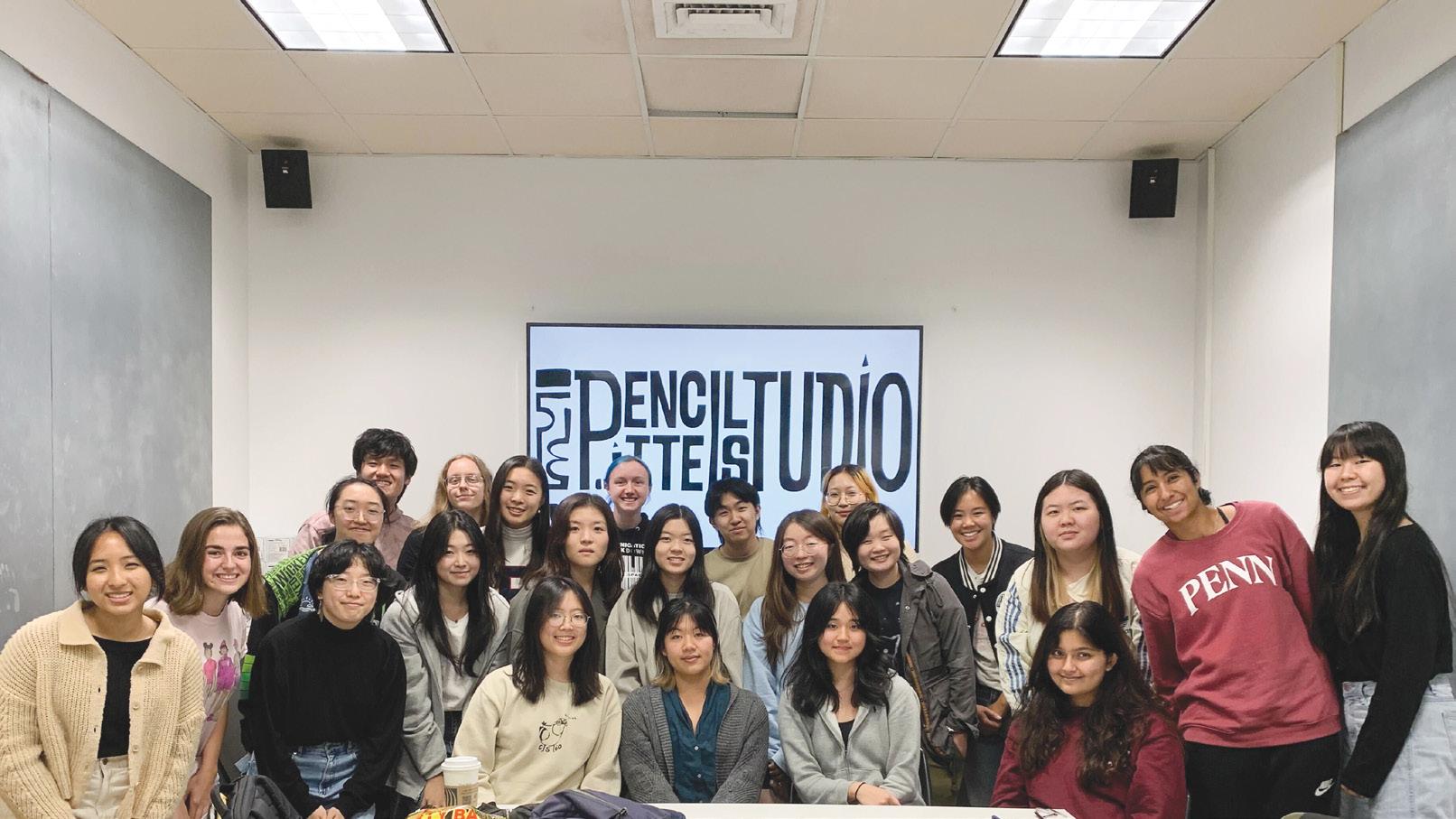
“I don't think I'm alone in saying the animation industry is something that feels very intimidating,” Wang, a design editor for the DP, said, "It feels like there's a lot of hoops and connections and just fate that goes along with getting there.”
The team has a plan in place to overcome these industry obstacles. Drawing events, animated movie screenings, and industry alumni speaker events have already been planned and are set to take place throughout the year.
“We're building a space on campus where we can really foster that passion for animation and hopefully get people exposed to real industry practices,” Engineering senior and Pencilbite producer Cindy Xu said.
The Pencilbite Studio team said that the club is filling a much-needed hole in the Penn community.
“Penn has a serious lack of creative clubs that are actually producing creative material and material that other Penn students can watch and admire,” College senior and member of the production team Erica Messics said.
Local 153 organizer Scott Williams, a 2016 graduate of Penn’s Graduate School of Education, previously told the DP that the next step is for RAs to nominate and elect a bargaining committee, which will be responsible for drafting proposals and collecting input from their peers.
“Everything is on the table,” Williams added, when it comes to negotiating with the University.
This could include retroactively changing existing contracts to meet union proposals, though he said that “it’s subject to negotiations.”
Penn RAs’ unionization continues a trend among peer universities, including Columbia University, Barnard College, Wesleyan College, and Tufts University. Senior Reporters Molly Cohen and Jared Mitovich contributed reporting.
University spokesperson Ron Ozio wrote in a statement to The Wall Street Journal on Wednesday.
A flash mob event celebrating Karikó and Weissman took place following the morning press conference outside Smilow Commons at 1 p.m. Magill, Jameson, Kevin Mahoney, CEO of UPHS, and Jon Epstein, executive vice dean and chief scientific officer of the Medical School, were all in attendance.
At the flash mob, students and faculty from the University and medical community crowded to get a glimpse of the Nobel Prize-winning duo and take photos with them.

“The fact that Katalin persisted, kept going, and got a Nobel Prize after she couldn’t get tenure and couldn’t get a grant is amazing," Perelman School of Medicine professor Sarah Tishkoff said. "She’s an inspiration for all women — women scientists in particular.”
Weissman stated at the press conference that mRNA-based trials are currently in process for seven vaccines, including cancer vaccines, vaccines for autoimmune diseases, and allergens.
"My lifelong dream has always been to put something that I developed into people and to have it make a difference,” Weissman previously told The Daily Pennsylvanian in 2020. Karikó and Weissman have since won a
multitude of awards for their research. Among others, they have been named TIME Magazine’s Heroes of the Year, awarded the 2021 LaskerDeBakey Clinical Medical Research Award and the 2022 Breakthrough Prize in Life Sciences, and inducted into the National Inventors Hall of Fame.
Karikó and Weissman become the 28th and 29th Nobel laureates affiliated with Penn and join nine prior Penn-affiliated Nobel laureates who have won the Nobel Prize in Medicine. Karikó and Weissman first met in 1997 while waiting in line to use a copy machine. They soon began working together on mRNA research.
In 2005, Karikó and Weissman published research that found that mRNA could be changed in a laboratory and used for therapeutic purposes. They discovered that modifying RNA using a naturally occurring modified nucleoside could reduce RNA’s inflammatory potential and cause a higher production of antigenic protein, which is critical for vaccine development.
“We would sit together in 1997 after work and talk about all the things we thought RNA could do — all of the vaccines, therapeutics, and gene therapies — and then just realize it had the potential to be, and that is why we never gave up,” Weissman said at the press conference.










The Academy, founded in 2017, provides a space for athletes and coaches to collaborate with Wharton leaders
In 2017, following a $1 million donation from a former Penn standout wrestler and football player David Pottruck, the University announced the creation of a new program: the Penn Athletics Wharton Leadership Academy. The program is designed to cultivate the leadership abilities of student-athletes through a partnership between the athletics department and the Wharton School’s Anne and John McNulty Leadership Program. The goal of the program is to provide a space where both coaches and athletes could participate in lectures, workshops, and experiential sessions in order to build a culture where student-athletes and staff members can collaborate more effectively.
Checking back in on the program nearly six years later, it would seem as if the Academy has achieved its original purpose.
Coming into Penn usually takes a toll on the mentalities of many recruited student-athletes, especially as plenty of the recruits are coming from environments where they are used to being the best. The freshman curriculum, required for all student-athletes, spends a large portion of its time focused on what leadership
 VIVIAN YAO Sports Associate
VIVIAN YAO Sports Associate
looks like, with a huge emphasis on how to be a good team player. Split into groups led by junior student-athlete facilitators, the freshmen — coming from a variety of athletic and academic backgrounds — get their first taste of how leadership principles can be applied directly to their crafts.
Following that freshman year curriculum, student-athletes are given the opportunity to opt out of the program heading into their sophomore year. It speaks volumes about the program’s quality and usefulness that most sophomores continue to partake in its activities.
“I like to think of myself as a leader,” said junior lightweight rower Troy Riesenberger. “but I’m also always trying to develop that skill set to become better at what I’m doing. So that’s a big aspect of the second part of the program that I really enjoy.”
A key part of the sophomore-year curriculum is the more personalized design with which student-athletes are approaching their leadership skills. Athletes take the “Dominance, Influence, Steadiness and Conscientiousness” assessment, which is a behavior assessment tool designed to help people understand their
leadership styles. What makes this assessment so noteworthy for many of the student-athletes is how they can be used to make teams stronger.
“Taking this test allowed me to evaluate how I could contribute best to my team and what some of my strengths were, and then also what some of my weaknesses are when it comes to being a good teammate,” junior volleyball outside hitter Ella Green said. “Having other people on my team also take this test helped us better understand each other.”

Many student-athletes — especially those poised to undertake leadership roles such as captaincies on their respective teams — return to the program in their junior and senior years. The biggest change that comes from these two years is that the students are now taking on more responsibilities and stepping into bigger leadership roles within the programs. As juniors, they become the facilitators leading freshman groups and putting the concepts they have previously learned into practice.
“I really found that it was a great opportunity to get in the minds of younger people,” senior wrestler Lukas Richie said. “It was also a chance to look back on how much my mindset coming into college and coming into the Division I athletic world at an Ivy League institution has changed.”
One of the more unique aspects of the program is the ability for student-athletes to connect with other student-athletes who play different sports that they wouldn’t have had the chance to get to know otherwise. By having the groups set up such that there was a diverse mix of the various athletic teams represented, the Penn Athletics Wharton Leadership Academy has done a lot to create a more cohesive sporting environment at Penn.
Despite the very promising start, there is still plenty of room for improvement for the
relatively young program. Getting the freshmen to be more involved and interested in the curriculum has been a struggle in the past, which leads to some athletes choosing to not continue with the program. Furthermore, there seems to be some discrepancies that exist concerning how active some of the sports teams are. Moving forward, this will be a point worth tackling in order to ensure that the Academy can maximize its potential to cultivate leaders for the sports teams here at Penn.
“I think this is so promising to see how engaged and how much people are enjoying it now, especially when it’s still in its premature stages,” junior women’s lacrosse midfielder Anna Brandt said. “So I’m so excited to see where it’s going to go. It has so much potential, so I know there’s just so much promise for the future.”










Members of the DP’s Sports staff predict football’s fourth game of the season against Georgetown.
Caleb Crain, Sports Editor Penn 38, Georgetown 17
Walker Carnathan, Deputy Sports Editor Penn 21, Georgetown 17
Vivian Yao, Sports Associate Penn 24, Georgetown 27
Griffin Bond, Sports Associate Penn 42, Georgetown 21
Kristel Rambaud, Sports Reporter Penn 34, Georgetown 24
The Daily Pennsylvanian sat down with Abigail Reid, Penn volleyball’s starting libero — an honorable mention All-Ivy selection last season — right before the team left for their game against Yale to ask her 15 questions about her goals, her go-to Wawa order, and pre-game rituals.
1. Could you please introduce yourself?
Hi, my name is Abby Reid. I’m a sophomore libero for the UPenn volleyball team.
2. So what got you into volleyball?
My mom actually made me try out for volleyball in sixth grade because I hated it — I tried in fourth grade and I didn’t like it. I was a soccer, basketball girl. Then my mom was like, “I really think you could be good at it.” So she made me try out, and I supposedly made it, and I was really bad. That’s kind of how I got into it.
3. So you’ve really dominated the back row since you came to Penn. What do you think fuels your success?
I’ve always been super competitive. Coming here, I wanted to make a statement my freshman year and make my presence known at Penn and in the Ivy League. Looking at other liberos on other courts and on other teams and seeing how good they are makes me want to be better: I want to be better than her. I want to out-dig her. I want to lead the Ivy League in whatever statistic. I came in last year and this year really still wanting to prove myself. Don’t sleep on me. That motivated me to be better than the liberos out there, especially in the Ivy.
4. What do you like most about being a libero?
What’s so special about being libero is that you are captain of the defense. You run that back row, and I really like having that responsibility; being able to take charge and telling everyone where to hit, where’s the receive route, where seams are. I also like that people turn to me — they trust me, they believe in me, and they’re passing next to me. They know we’re [going to be] fine.
5. Why did you choose to come to Penn?
[Coach Meredith Schamun] was a huge reason why I chose Penn. She was recruiting me from Villanova, and then brought me here — within all the other schools, Penn was definitely the hardest pursuer. Also, you can’t really pass up on an Ivy League education.
6. How do you feel about your upcoming season?
I’m really excited. [Ivy League play] just started; it’s really early, and we had two big nights against Princeton that obviously didn’t come out [as] wins. But I think taking it the five is a really good sign for the future. Overall, we are a much better team compared to last year, especially with our mindset and mentality. We’re going to fight, fight, fight: we’re going to win, [and] we’re going to come out on top. Big things are ahead for Penn volleyball.
Reid started all 24 games and played in all 92 sets as Penn volleyball’s libero last season
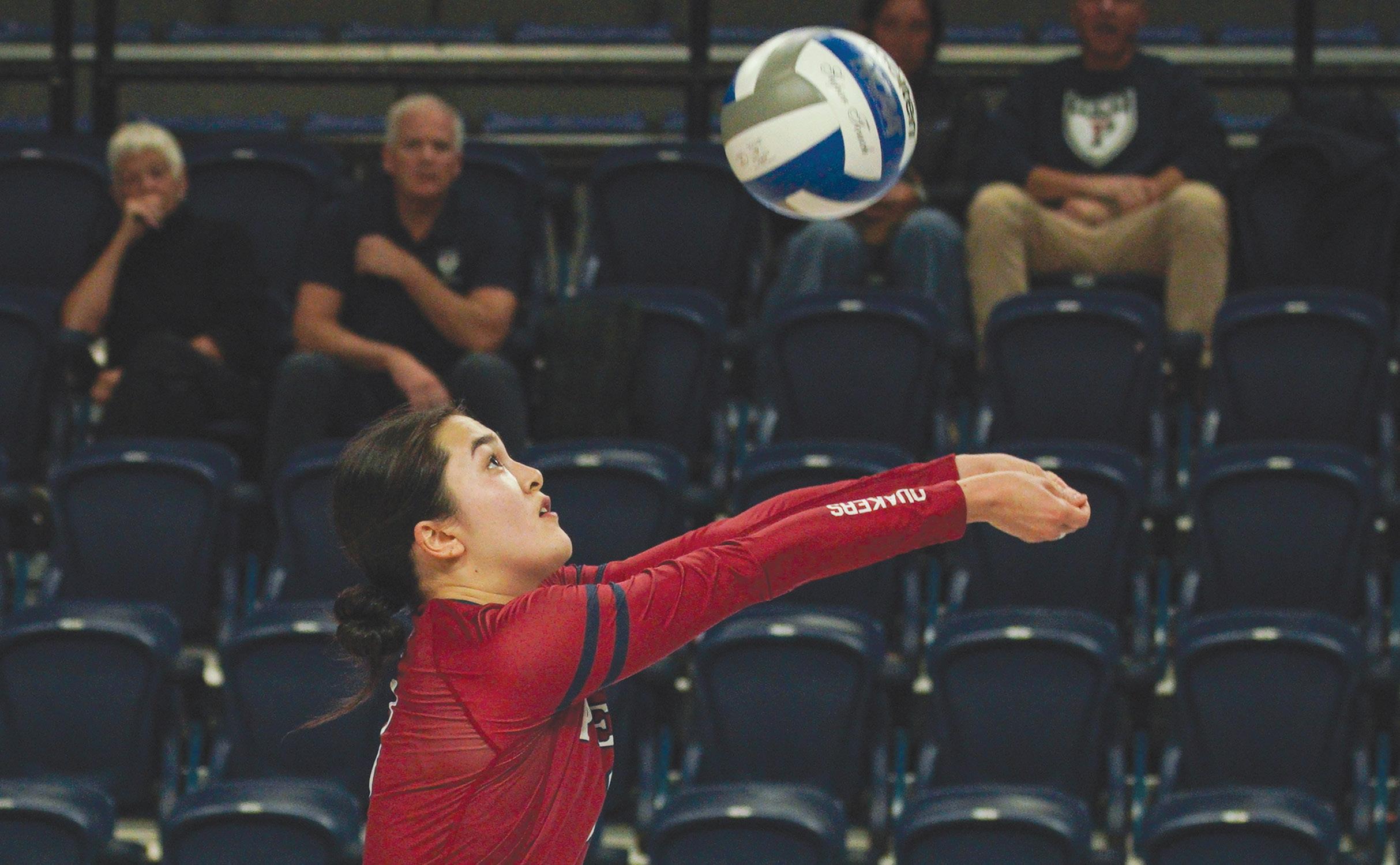
WEINING DING Sports Reporter
7. Do you have any fun pregame rituals?
As a team, we like dance parties in the locker room; we try and find a song of the year. Last year, it was “Addicted To My Ex,” which is such a crazy song. This year, it’s “Cotton Eye Joe” or “Footloose.” People do different things — some people lock in or some people dance. I think we all just dance [to] get the nerves out and get our bodies going and flowing.
8. What music have you been listening to recently?
That’s a good one. I really like Taylor Swift — she is my favorite artist of all time. Christian Kuria is also a really good artist. And then obviously, SZA. But definitely Taylor Swift; “folklore” is on repeat right now.
9. So what is a perfect day at Penn or in Philly like for you?
Probably a game day; game days are so much fun. I love waking up, and then I have recitations, then we always come [together] for pregame meals and have a fun locker room. Just getting to be with my team in that environment is really fun. [And] there’s like nothing like playing in the [Palestra] on Fridays and Saturdays — so playing, I think that’s a perfect day.
10. What are some things you do for fun around campus?
Gosh … Me and my friends get food a lot. We’ll go into different places around campus. Hummus Grill is the place to be — I love Hummus Grill — and Pattaya.


11. Do you have any hot takes?
Mint chocolate chip ice cream is good. So many people hate on it, and I don’t get why. I love mint-flavored things. So many people hate it because it tastes like gum — like, no, mint is so good.
To have a really positive mindset. It’s not always easy, especially when you’re in a tough season or tough games, or even moments in games where maybe you’re struggling or not feeling your best. So always have a positive mindset.
15. What is your favorite volleyball memory while you’ve been at Penn?
It would have to be when we beat Cornell in five at home. It was such a long season of losing, unfortunately, and we really wanted this win. We wanted all of our wins, but we were fighting for our lives in that

12. What’s your go to Wawa order?
I always get a BODYARMOR. And then I get a Gogo squeeZ. And then a Red Bull. The coconut Red Bull [is] probably my go-to. A lot of drinks; I gotta stay hydrated.
13. Is there a coach or athlete you look up to? Why?
There’s two that I look up to: Morgan Hentz, who was a Stanford libero, and Kayla Banwarth, who was the Nebraska libero a while ago and was on the Olympic team. [Hentz] won the national championship three times in her career at Stanford, and I would just watch her highlights over and over again as a way to mirror her. I watched [Banwarth’s serve receive] on repeat all throughout high school and I’m starting to do it again, because she just has the most stable serve receive I’ve ever seen in my life. I actually got to talk to Kayla Banwarth — she was the Ole Miss coach, and I was getting recruited by them, so I got to FaceTime her, and [that] was actually the biggest full circle [of] my life.
14. What is your advice to young volleyball players at Penn?
season. I remember, we were on the fifth set ... they served it, they swung, and they hit it at me and I dug it and then [Anna Shohfi] set Abby, and we swung and scored in the court. I remember just like, falling to the ground, [and] we all ran around and hugged each other. I literally started crying, which is crazy, because I don’t cry. It was nice, winning with your seniors, and obviously beating another Ivy opponent — the rivalry is insane. You have a chip on your shoulder because it’s Yale, or it’s Columbia. That was probably my favorite memory.
Unlike other varsity sports, the program relies on athletes reaching out with interest rather than traditional recruiters
EVAN POWERS Sports AssociateAmid the bustling energy of Penn Athletics, there’s a sport that dances to its own rhythm.
Sprint football, unique in its recruitment approach, has become a fascinating tale of passion and perseverance. If you frequent The Daily Pennsylvanian’s Instagram account or weekly print publication, you may have encountered a recruitment advertisement or two, calling out to former high school athletes to consider sprint football. Unlike other varsity sports, the coaches within sprint football don’t travel to spot their next star player. Instead, the players find the game.
High school coaches, passionate about their students’ futures, alert them about Penn sprint football. Eager young athletes, hearing of opportunities, take the first step by reaching out directly to Penn’s sprint football administration. Once that line of communication begins, it’s more than just gauging their skill on the field. It’s about understanding their dreams and their academic aspirations.
Potential recruits need to excel in the classroom before they can even think of sprinting on the field. But it’s not only football skills that the team is after. “We are looking at many types of skill sets — not just football players in high school, but other sports such as basketball, baseball, and track experience are great fits for our program as well,” sport administrator Mike Martin said.
Penn football suffered a closely fought but narrow 23-20 defeat in overtime
The Quakers enter the matchup riding a three-game win streak against the Hoyas
VIVIAN YAO SportsAssociate
After a disappointing result last week, losing in overtime to Dartmouth at home, Penn football (2-1, 0-1 Ivy) will have a chance to right the ship as it faces its third Patriot League opponent of the season in Georgetown (3-2) for the second home game of the season.
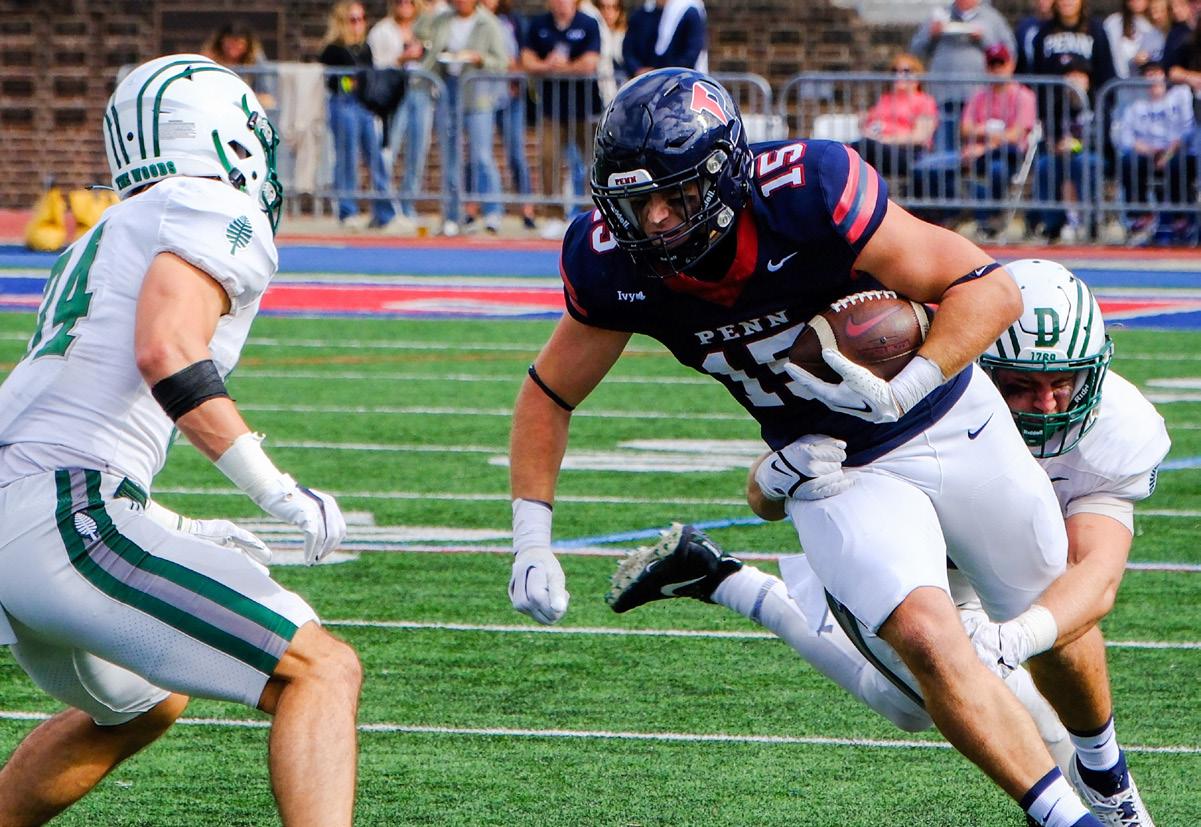
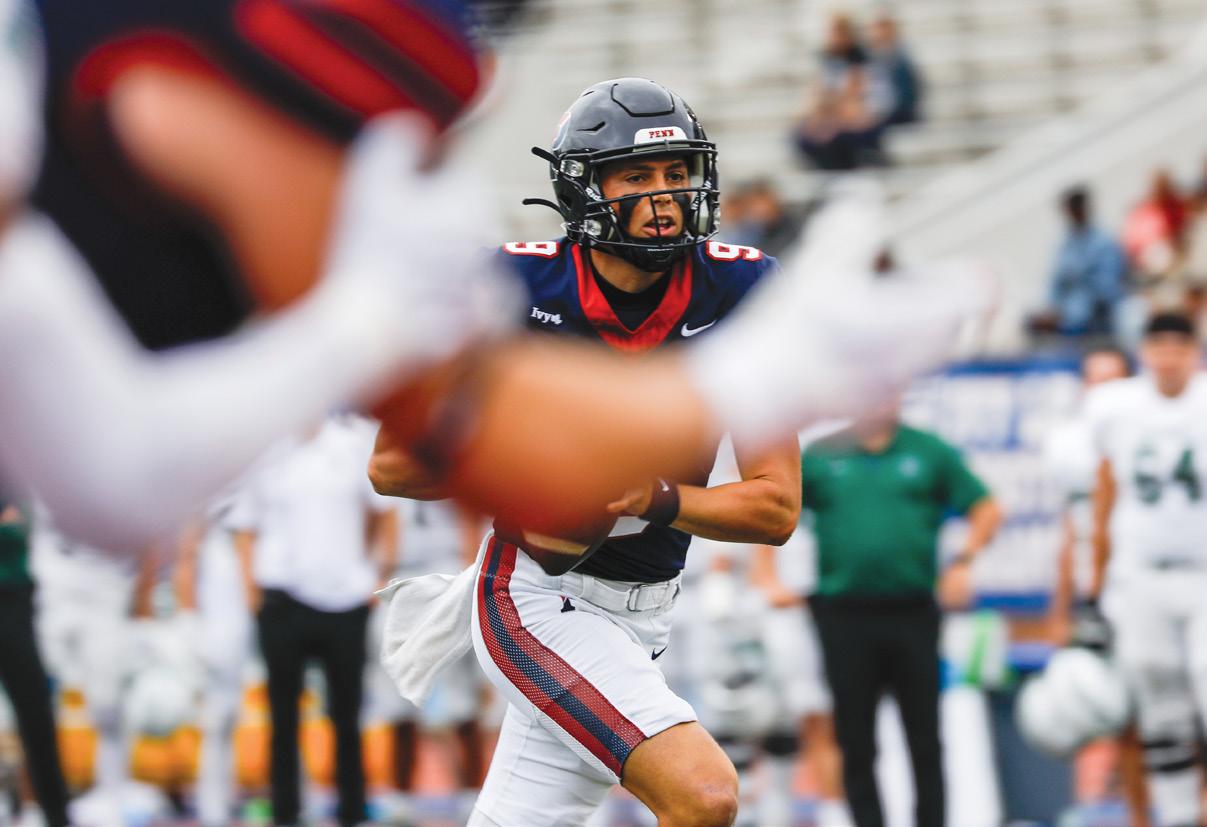
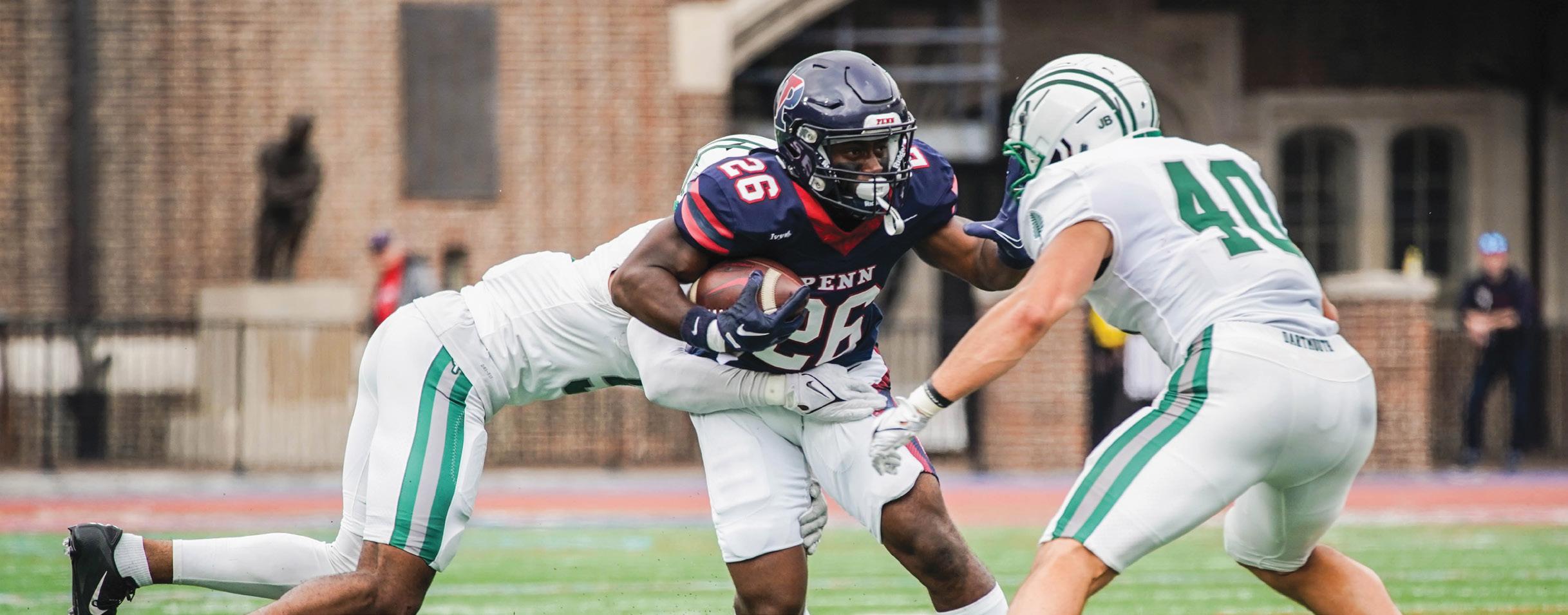
In the last meetup between these two teams, Penn absolutely dominated the Hoyas in all facets of the game en route to a commanding 59-28 win at Georgetown’s homecoming game. A lot has changed since that game, though.
Many of the Red and Blue’s stars in that game — outside of junior quarterback Aidan Sayin — have all moved on to continue their collegiate football careers elsewhere, while the Georgetown program has seen noticeable improvements heading into the season this year. Before the two teams met last year, Georgetown had won just one game and were deep in a four-game losing skid. This season, Georgetown has already notched three wins and is coming off a solid victory against a conference opponent. Furthermore, Georgetown has one of the top defenses in the Patriot League, ranking first against
the pass and third against the run.
However, Penn’s track record against Patriot League opponents has been stellar thus far. To open the season, Penn dominated two Patriot League teams in consecutive weekends on the road. In fact, the last time the Quakers lost to a Patriot League team was over two seasons ago to Lafayette. This season, Georgetown was held scoreless against fellow Ancient Eight member, Columbia, which bodes well for a Penn defense that is ranked third in the Ivy League. A key point of focus for the Quakers heading into this weekend will be minimizing turnovers. In each of the team’s first three games, at least two turnovers resulting in points scored have been committed. While Colgate and Bucknell failed to punish Penn for its lack of ball security, the game against Dartmouth showed what can happen when Penn repeatedly gifts its opponents with good field position. The Hoyas — who have already stacked up 114 yards off of four interceptions this season — will be an opponent that will feast on any turnovers that Penn commits.
Konopka was a captain for the team during her senior year last season
ANIKA GURURAJ Sports AssociatePenn women’s rowing has a new addition to their coaching staff in assistant coach Josie Konopka, the team’s former captain. While having a collegiate coach would be considered unique in most families, for the Konopkas, rowing runs deep.
Both of Konopka’s parents and brother coach rowing at the collegiate and varsity levels. Growing up, Konopka attended rowing camps, which began her love for the sport. She then competed for her high school team, which was coached by her mother, and joined Penn’s rowing team, which she later became the captain of. When it came time to look to her post-graduation plans, entering coaching felt like a natural progression.
“Coaching at Penn felt like the perfect opportunity since I had already worked so closely with [associate head coach Kumari Lewis] and [head coach Wesley Ng],” Konopka said. “That transition would be smooth and that I would have people around me who really understand me.”
While the coaching staff were familiar faces to Konopka, her transition from being captain of the team to its assistant coach meant having
to take on a more authoritative role and learning how to communicate feedback effectively to the team.
“When you’re on the team, you don’t have any more authority than anyone else on the team,” she said. “Now I have more authority to steer the athlete in the direction we as a coaching staff would like to unlock their full potential.”
This emphasis on increased communication as a coach has been a learning process for Konopka, and she believes there are always more techniques she can pick up with experience to improve her capabilities as a coach.
“When I’m rowing, I know what an improvement should feel like. As a coach, I’ve been learning to communicate and demonstrate those changes to the girls. It’s been really helpful to learn from [Lewis] and [Ng] and watch them while conducting the practice sessions,” she said. “ I’m also learning a lot from the broader support staff and from the men’s coaching team.”
Being an assistant coach has unexpectedly also provided more of a behind-the-scenes perspective to the season, as she now is involved
Once again, the Red and Blue will be going up against a very competitive pass defense unit. With the emergence of sophomore wide reciever Jared Richardson and junior tight end Bryce Myers, and with Sayin throwing for over 300 yards for each of the past two games, Penn will be looking to establish its dominance through the air against a pass defense unit that is ranked first in the Patriot League. On the other side of the ball, Penn’s defense, ranked second in the Ivy League — and fourth in the FCS — in rush yards allowed per game, should line up well against a Georgetown offense that has relied heavily on the run thus far in the season.
The game will likely come down to which team can win in the trenches. Penn’s offensive line has generally performed strongly, although there were a few moments where defenders were given straight shots to Sayin this past weekend — one of which resulted in a strip sack. If the offensive line can clean things up slightly and buy Sayin some time, it isn’t beyond the realm of possibility for Sayin to throw for over 300 yards for his third consecutive game.
The team’s dynamic is like a jigsaw puzzle. The pieces must fit not just athletically but positionally. The search isn’t just for any player, but for someone who can fill the spaces left behind by injured players, or those who’ve moved on to focus on their academics. As they progress through this distinct recruitment process, what truly defines their fate?
Admission.
The list of names that get the green light academically is the pool from which the team emerges. Building a team is more than just getting the players together. It’s about creating bonds and understanding one another. That’s why every freshman is nudged to connect before they even set foot on Locust Walk. Every conversation with the coach is a step closer to understanding the heart of the game and the philosophy behind it.
“We encourage each incoming freshman to reach out to one another prior to arriving on campus to begin building a relationship,” Martin said. “I talk to each player when permitted which helps players get to know me as an individual and understand my coaching philosophy.”
This year, the field has seen its fair share of challenges. The loss of players due to injuries and academics has left the team with gaps that are waiting to be filled. But every challenge is an opportunity in disguise.
“We would love to get the word out that Penn sprint football is looking for athletes to join the team in the spring,” Martin further echoed. With hopes high, the program is on the lookout for passionate athletes ready to join their ranks next spring.
A day of tryouts awaits, with dates soon to be broadcast across social media channels. Regardless of the chaos of the recruitment process, Penn sprint football is still more than ready to make potential history in its next chapter.
Penn women’s rowing’s newest assistant coach and former team captain Josie Konopka during last season’s Navy Day Regatta on Oct. 16, 2022. in directions regarding the focus of practice sessions and the wider goals of the team in the coming weeks.

“I just have a lot more information now. I work with the broader support staff as well and they’ve been super welcoming and happy to have me on board,” said Konopka. When looking to the future, Konopka reiterated her pursuit of furthering her ability to coach effectively.
“No one is ever a finished product, so I’ll
always be able to learn about coaching and figure out ways I can further help the team,” she said.
Konopka holds the unique perspective of having captained many of the players on the team, sharing a relationship with them that is now transitioning from a comrade to a more authoritative figure, but the trait that remains in this shift is the importance Konopka places on providing support in order to help the team reach its maximum potential.